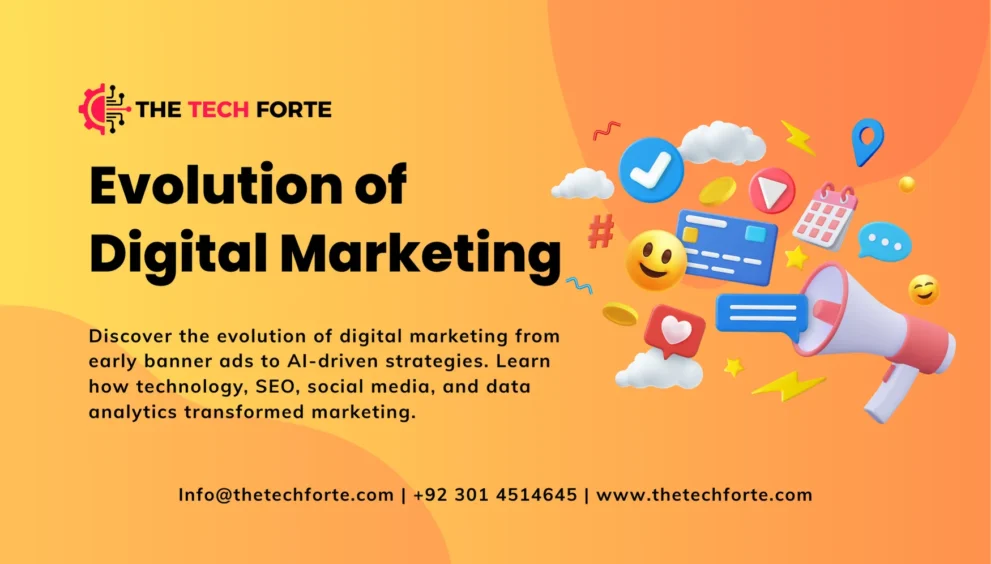Evolution of Digital Marketing: From Banner Ads to AI-Driven Strategies

Digital marketing has come a long way since its early days in the mid-1990s. What began with simple banner ads has evolved into a complex, data-driven ecosystem powered by artificial intelligence, automation, and personalized user experiences. Understanding the evolution of digital marketing not only helps us appreciate how far the industry has progressed but also provides valuable insights into where it is heading.
In this article, we’ll explore the journey of digital marketing, covering key milestones, technological advancements, and the shift from traditional online advertising to AI-powered strategies.
The Early Days: Banner Ads and Static Web Marketing
The first digital marketing breakthrough came in 1994, when AT&T ran the very first banner ad on Wired.com. The ad simply asked, “Have you ever clicked your mouse right here?” and remarkably, 44% of viewers clicked it, a click-through rate unheard of today.
In those days:
- Websites were static, with limited design and interactivity.
- Marketers focused on impressions rather than user behavior.
- Email newsletters were emerging as another digital channel.
This era marked the birth of online visibility, but personalization and targeting were almost nonexistent.
The Rise of Search Engines and SEO
By the late 1990s and early 2000s, search engines like Yahoo! and Google changed the way people discovered information. Marketers quickly realized that ranking higher on search results meant more visibility and traffic.
This gave rise to Search Engine Optimization (SEO). Early SEO involved keyword stuffing, hidden text, and link spamming—tactics that would be penalized today. As Google improved its algorithm with updates like PageRank, SEO shifted toward quality content and relevance.
Key developments during this phase included:
- Paid search ads (Google AdWords launched in 2000).
- Organic SEO best practices.
- The beginning of data-driven decision-making.
Social Media Changes the Game
The mid-2000s introduced platforms like Facebook (2004), YouTube (2005), Twitter (2006), and LinkedIn (2003), which redefined digital marketing strategies.
For the first time, brands could:
- Directly engage with audiences.
- Use targeted ads based on demographics and interests.
- Build communities around their products.
Social media marketing became about two-way communication rather than one-sided advertising. User-generated content, influencer collaborations, and viral campaigns became integral parts of digital strategy.
Mobile Marketing and the App Era
With the launch of the iPhone in 2007 and the Android ecosystem shortly after, mobile marketing exploded. Suddenly, consumers were online 24/7, and marketers needed to adapt.
Strategies evolved to include:
- Responsive websites optimized for mobile screens.
- Mobile apps as brand engagement tools.
- SMS and push notifications for instant communication.
- Location-based marketing using GPS.
Mobile-first thinking became essential, shaping how businesses designed websites, content, and campaigns.
Content Marketing and Inbound Strategies
By the 2010s, the digital marketing industry had matured. Consumers grew resistant to interruptive ads (banner blindness, ad blockers), leading brands to shift toward content marketing and inbound strategies.
Marketers started focusing on:
- Blogs, eBooks, and whitepapers.
- Educational videos and webinars.
- Storytelling and brand voice.
- Long-term relationships instead of one-off sales.
The mantra became: “Provide value first, then sell.”
Data-Driven Marketing and Personalization
As analytics tools like Google Analytics improved, marketers gained deeper insights into user behavior. This led to the rise of data-driven marketing, where campaigns were customized based on:
- User demographics.
- Online behavior.
- Purchase history.
Email automation platforms, CRM systems, and advanced targeting allowed businesses to personalize messages at scale, improving engagement and conversions.
AI-Driven Strategies: The New Era
Today, we are in the era of AI-driven digital marketing. Artificial intelligence and machine learning are transforming how businesses connect with consumers.
Modern strategies include:
- Predictive analytics to forecast consumer behavior.
- Chatbots and conversational AI for real-time customer service.
- Programmatic advertising that automatically buys and optimizes ads.
- Personalized recommendations powered by AI (e.g., Amazon, Netflix).
- Voice search optimization with smart speakers like Alexa and Google Assistant.
- Generative AI is creating ad copy, images, and video content instantly.
AI is not just automating processes—it’s enabling smarter, faster, and more personalized decision-making across every digital channel.
The Future of Digital Marketing
Looking ahead, digital marketing will continue to evolve alongside technology. Some emerging trends include:
- Augmented Reality (AR) and Virtual Reality (VR) for immersive brand experiences.
- Hyper-personalization using real-time data.
- Blockchain technology for ad transparency and fraud prevention.
- Sustainability-focused marketing appeals to socially conscious consumers.
Marketers who embrace innovation while maintaining ethical and customer-first practices will stay ahead in the ever-changing landscape.
Final Thoughts
The journey of digital marketing from the first banner ad to today’s AI-driven strategies illustrates the power of technology to transform communication. What started as static ads has grown into a sophisticated ecosystem where data, personalization, and AI work together to deliver impactful customer experiences.
For businesses and marketers, the key takeaway is clear: evolution never stops. Staying informed and adaptable is the only way to thrive in this fast-paced digital world.





























































































































